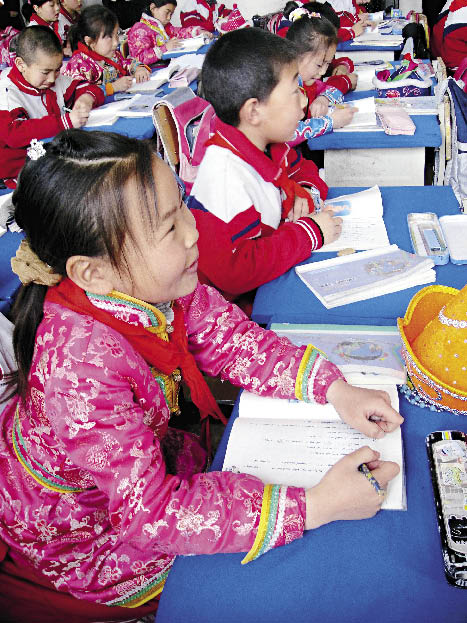| For the Children of the Grasslands
By staff reporter CHENG WENJUN
HAS Uyanga is a pupil of the Mongolian School in Hohhot, capital of Inner Mongolia Autonomous Region. Mongolian is her mother tongue but Has also studies Chinese and English at school. “My name means ‘jade’ in the Mongolian language,” the girl introduces herself. “We enjoy many traditional Mongolian activities at our school.” Every morning girls perform the Andai Dance while boys face off with traditional Mongolian wrestling in the playground. After class in the afternoon, Has also attends a class to practice the Morinhuur – the Mongolian horse-head fiddle.
“I Wanna Learn Mongolian”
In Hohhot, all road signs and shop awnings are bilingual – Mongolian and Chinese. According to Yang Huiliang, a division head of the Department of Education of Inner Mongolia Autonomous Region, it is an essential requirement for students from the Mongolian ethnic group to have perfect command of their mother tongue. The bilinguality is highly appreciated. Yang believes that mastering several languages will be advantageous in their future work and lives.
 |
|
Students at a Mongolian school enjoy their multilingual classes. |
Inner Mongolia Autonomous Region was the first minority-inhabited area to implement a policy of regional autonomy for the several ethnic groups living in this region. The Han people make up around 77 percent, while the Mongolian ethnic group makes up 18 percent of the region’s total population of 24 million. Today, a bilingual educational system is in place from kindergarten to college. The Mongolian-language schools must offer courses in Chinese and some other foreign languages, while Chinese-language schools offer courses in Mongolian. In this way, Mongolian children have the opportunity to learn both languages at the same time and Han students along with those from other ethnic backgrounds have the chance to learn Mongolian as well.
Located at the foot of Daqing Mountain, 100 kilometers away from Hohhot, Tumd Left Banner was a former outpost for the nomads who roamed the vast grasslands. However, as the local economic structure changes, many herdsmen have become farmers or moved to urban centers to live and work. The younger generations only learn to speak Mandarin and the Mongolian language is dying out. “But How can we inherit our ethnic culture if we can’t communicate in our mother tongue?” objects Yang Wensuo, principal of the Tumd Left Banner Middle School of Nationalities.
To save the language, schools in Tumd Left Banner have set up classes in both Chinese and Mongolian languages for all students. In the beginning, many parents did not support the bilingual classes, worrying that their children may not be able to manage two languages simultaneously. Nevertheless, they have come around and more and more parents are now registering their children for bilingual classes. Tsetsegee, a seven-year-old girl in such a class, says, “I’m a Mongolian, so I long to learn the language of my ancestors. Luckily I have an excellent teacher.” According to Yang Wensuo, even Han students are showing great interest in learning the Mongolian language.
Fiscal support from the regional government has been on the rise in recent years. A student boarding at a Mongolian-language primary school is subsidized with RMB 1,080 per academic year and those at junior highs with RMB 1,350. The regional government allocated RMB 272 million in subsidies for 2009.
| 